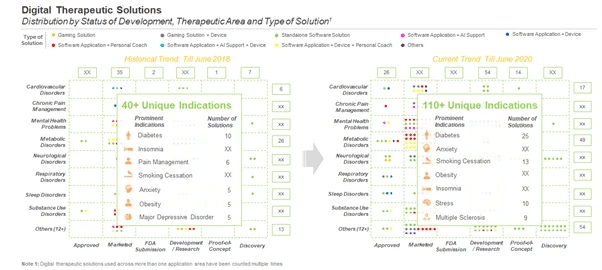A major increase in the number of different types of solutions for treating various indications, has been observed in the past two years. In fact, from June 2018 to in June 2020, there has been increase of 22 approved and 106 marketed digital therapeutic products.
To order this 130+ slides report, which features 80+ figures, please visit https://www.rootsanalysis.com/reports/digital-health-market-focus-on-digital-therapeutic-monitoring-and-diag/request-customization.html
Further, over the years, mental health problems and metabolic disorders have gained much interest from the developers. Of note, majority of the marketed solutions are intended to be used in patients with mental health problems, while majority of the approved products find applications in treating metabolic disorders. Similarly, a huge number of solutions are in development / research stage focused on mental health problems and neurological disorders Furthermore, in the recent years, developers have also shifted their focus towards developing digital therapeutic solutions targeting neurological, cardiological and substance use disorders. This can be attributed to the fact that these therapeutic areas have highest number of solutions under development.
It is worth mentioning that majority of the solutions target diabetes (25), followed by anxiety (17), smoking cessation (13) and obesity (12), highlighting the interest of developers towards metabolic disorders and substance use disorders. Of note, majority of the solutions targeting diabetes provide curative therapy (76%).
To request a sample copy / brochure of this report, please visit this - https://www.rootsanalysis.com/reports/208/free-insights.html
In addition, majority of the solutions have been / are being developed by small-sized players (~40%), followed by very small-sized players (~31%). In fact, most of the solutions by small-sized players are focused on mental health problems, followed by metabolic disorders and neurological disorders. Similarly, most of the solutions by very small-sized players are focused on neurological disorder, digestive / gastrointestinal disorder and mental health problems. Further, large players are majorly involved in developing solutions for metabolic disorder, whereas mid-sized players are largely focused on mental health problems and metabolic disorders.
In fact, in an interview with the Vice-President of marketing from an industry player, she stated that “digital therapeutics are most effective as a combination therapy along with pharmacological solutions. This is especially true in the case of indications that we are live in namely type 2 diabetes, heart disease and cardiovascular disease.”
For additional details, please visit - https://www.rootsanalysis.com/reports/view_document/digital-health-market/208.html
You may also be interested in the following titles:
Progressive Supranuclear Palsy: Pipeline Review, Developer Landscape and Competitive Insights, 2021-2030Squamous Non-Small Cell Lung Cancer: Pipeline Review, Developer Landscape and Competitive Insights, 2021-2030Polycystic Ovarian Syndrome (PCOS): Pipeline Review, Developer Landscape and Competitive Insights, 2021-2030
Contact Details
Ben Johnson
+1 (415) 800 3415
ben.johnson@rootsanalysis.com
Roots Analysis
Web: https://www.rootsanalysis.com/
LinkedIn: https://in.linkedin.com/company/roots-analysis
Twitter: https://twitter.com/RootsAnalysis.com
Medium: https://medium.com/@RootsAnalysis
Pinterest: https://in.pinterest.com/RootsanalysisPin/_saved/
Quora: https://rootsanalysisinsights.quora.com/
0


